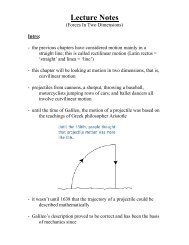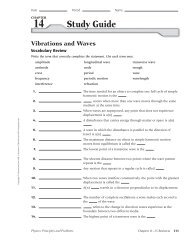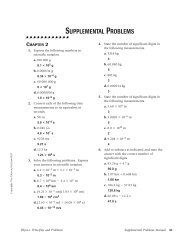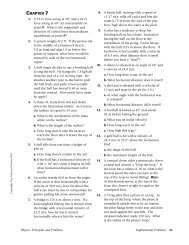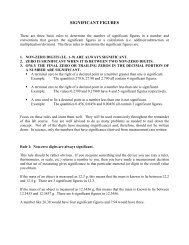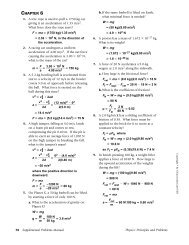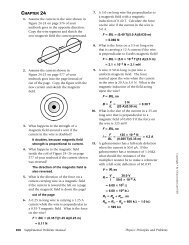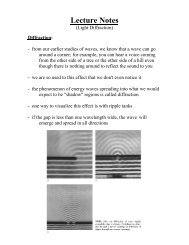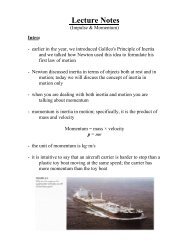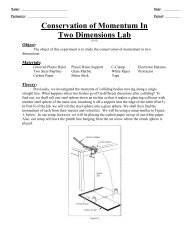Lecture Notes (Electric Fields) - Dickey Physics
Lecture Notes (Electric Fields) - Dickey Physics
Lecture Notes (Electric Fields) - Dickey Physics
- No tags were found...
Create successful ePaper yourself
Turn your PDF publications into a flip-book with our unique Google optimized e-Paper software.
<strong>Lecture</strong> <strong>Notes</strong><br />
(<strong>Electric</strong> <strong>Fields</strong>)<br />
Intro:<br />
- the gravitational force and the electrostatic force are both<br />
capable of acting through space, producing an effect even<br />
when there isn’t any physical contact between the objects<br />
involved<br />
- field forces can be discussed in a variety of ways, but an<br />
approach developed by Michael Faraday (1791–1867) is the<br />
most practical<br />
- in this approach, an electric field is said to exist in the region of<br />
space around a charged object; the electric field exerts an<br />
electric force on any other charged object within the field.<br />
<strong>Electric</strong> Field:<br />
- an electric field cannot exert a force on the charge which<br />
generates it, in just the same way as you cannot pick yourself<br />
up with your own shoelaces
- electric fields are real; there is an energy associated with an<br />
electric field which fills space; it is actually possible to covert<br />
this energy into heat or work, and vice versa<br />
- an electric field is a vector quantity; it has both magnitude and<br />
direction; the strength is the force per unit charge<br />
- if a body with charge, q, experiences a force, F, at some point in<br />
space, then the electric field, E, at that point is:<br />
<br />
- the units of electric field strength are N/C (newtons per coulomb)<br />
- the electric field is depicted with vector arrows; the direction of<br />
the field is shown by the vectors and is defined to be the<br />
direction in which a small, positive test charge at rest would<br />
be moved<br />
- the test charge is required to be very small, so it doesn’t cause<br />
any significant rearrangement of the charge creating the<br />
electric field<br />
- the direction of the force and that of the electric field at any point<br />
are the same
- if we start with an example of a negatively charged ball, all the<br />
vectors would point to the center of the ball<br />
- any charge placed in an electric field experiences a force on it<br />
resulting from the electric field at that point<br />
Picturing the <strong>Electric</strong> Field:<br />
- a more useful way to describe an electric field is with electrical<br />
lines of force (electric field lines)<br />
- the electric field lines represent a small number of the infinitely<br />
numerous possible lines that indicate direction of field<br />
- the electric field is tangent to the field lines at all points
- for a single point charge the lines extend to infinity; they point<br />
away from a positive charge and toward the negative point<br />
charge<br />
- for two or more opposite charges, we represent the lines as<br />
emanating from the positive charge and terminating on the<br />
negative charge
- the electric field concept helps us not only understand the forces<br />
between isolated, stationary bodies, but also what happens<br />
when charges move<br />
- the electric field is a storehouse of energy which may be<br />
transported over long distances; this energy may be directed<br />
through metal wires or teamed up with a magnetic field to<br />
move through empty space<br />
Van de Graaf Machine:<br />
- in 1929, Robert J. Van de<br />
Graaf designed and<br />
built an electrostatic<br />
generator that bears his<br />
name<br />
- everyday objects are made<br />
up of equal amounts of<br />
positive electric charge<br />
and negative electric charge in almost perfect balance; we<br />
might say that ordinary matter is made up of cancelled-out<br />
electricity<br />
- a VDG machine takes the mixed-up<br />
positive and negative charges of<br />
matter, sorts them out, then pulls<br />
them far apart from each other<br />
- a VDG is a charge uncanceller or<br />
charge separator; the machine<br />
moves charge continuously, so it<br />
also acts as a mechanical charge<br />
pump<br />
- the machine operates by use of a motor<br />
driven pulley
- the needles attract negative charges from the belt, causing one<br />
side of the belt to be positively charged<br />
- the charged belt attracts electrons from a second comb of needles<br />
found at the top of the device; this enhances the positive<br />
charge of the metal dome<br />
- a discharge occurs when the excess positive charge builds up on<br />
the dome; this is due to a strong electric field<br />
- when this field builds up enough strength, it will ionize the air<br />
around the dome; charges on the dome now have a way to<br />
leak off into the air which will produce lightning discharges<br />
- VDG machines were originally used as power supplies for the<br />
early particle accelerators used in research into radioactivity<br />
- big VDGs are also used to power high energy X-ray machines;<br />
if you want to treat cancer with radiation, make X-ray photos<br />
of locomotive engines, or sterilize food with gamma rays,<br />
you'll want to buy a Van de Graaff powered X-ray generator



